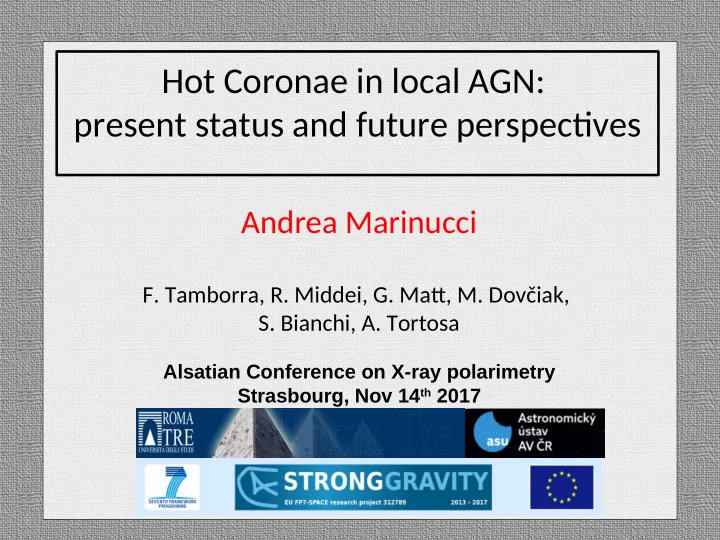

Hot Coronae in local AGN: present status and future perspecties Andrea Marinucci F. Tamborra, R. Middei, G. Mat, M. Doičiak, S. Bianchi, A. Tortosa Alsatian Conference on X-ray polarimetry Strasbourg, Nov 14 th 2017
Coronal parameters in local Seyfert galaxies One of the main open problem for AGN is the nature of the primary X-ray emission. It is due to Comptonizaton of sof photons, but the geometry, optcal depth and temperature of the emitng corona are largely unknown. Most popular models imply E cut =2-3x kT e (Petrucci+00,+01), so measuring E cut helps constraining Comptonizaton models. 1/15
Coronal parameters in local Seyfert galaxies Before the launch of NuSTAR, we only had a handful of results based on non-focusing, and therefore strongly background-dominated, satellites (BeppoSAX-PDS, Suzaku HXD-PIN, INTEGRAL, Swif-BAT) Type 1 Type 2 De Rosa+12; Molina+13 Perola+02 2/15
Coronal parameters in local Seyfert galaxies Tortosa+, in prep. So far, about twenty sources haie been obseried and their primary contnua iniestgated. 3/15
Coronal parameters in local Seyfert galaxies NuSTAR INTEGRAL Swift-BAT ALL Fabian+15 (Middei+; Tortosa+, in prep.) 4/15
Coronal parameters (Swif J2127.4+5654) Marinucci+14,+16 5/15
Coronal parameters (Swif J2127.4+5654) Marinucci+14,+16 Using compTT (Titarchuk+94) with two diferent geometries we get: SLAB SPHERE kT e =70 ± 35 keV kT e =50 ± 25 keV Statstcally =0.35 +0.35 =1.3 +1.0 -0.7 -0.20 equiialent 5/15
The -kT diagram (in a slab geometry) e 1. How can we translate the commonly deriied photon indices and high-energy cutof ialues into optcal depths and electronic temperatures?j 2. Is there a more populated region in the -kT parameter space?j 6/15
A MC code for Comptonizaton in Astrophysics (MoCA) kT e d =n dx e kn Assumptons and adiantages: 1. Shakura-Sunyaei neutral accreton disc 2. Extended coronae 3. Single photon approach 4. Polarizaton signal Tamborra+, submited 7/15
MoCA in acton We simulate a coronal confguraton and ft it with a cutof powerlaw, retrieiing the corresponding ialues of E and c Middei+, in prep. . M =10 7 M ; m=1, kT =100 keV; =1 bh sun e 8/15
MoCA in acton We simulate a coronal confguraton and ft it with a cutof powerlaw, retrieiing the corresponding ialues of E and c x Middei+, in prep. . M =10 7 M ; m=1, kT =100 keV; =1 bh sun e 9/15
The -kT diagram in AGN e The region of the obseried parameters ranges between kT=50-100 keV and =0.5-2.25 Middei+, in prep. 10/15
The -kT diagram in AGN e The region of the obseried parameters ranges between kT=50-100 keV and =0.5-2.25 Middei+, in prep. 10/15
The -kT diagram in AGN e We can defne the most populated region in both slab and spherical geometries but we cannot discriminate between the two. Middei+, in prep. 10/15
A fresh pair of eyes: X-ray polarimetry 1.8 % MDP for 2x10 -10 erg/s cm 2 Polarisation sensitivity (10 mCrab) in 300 ks IXPE (CBE) (Imaging X-ray Polarimetry Explorer) Spurious polarization <0.3 % Number of Telescopes 3 Selected by NASA (SMEX) Angular resolution 28’’ (CBE) for a launch in early 2021 Field of View 12.9x12.9 arcmin 2 Focal Length 4 meters P.I.: Martn Weisskopf (MSFC) Total Shell length 600 mm Range Shell Diameter 24 shells, 272-162 mm It will re-open the X-ray polarimetry Range of thickness 0.16-0.26 mm window! Effective area at 3 keV 854 cm 2 (three telescopes) Spectral resolution 16% @ 5.9 keV (point source) Resolution <8 μs Timing Accuracy 150 μs Operational phase 2 yr Energy range 2-8 keV Background (req) 5x10 -3 c/s/cm2/keV/det Sky coverage, Orbit 50 %, 540 (0 o ) 11/15
A fresh pair of eyes: X-ray polarimetry Tamborra+, subm. Since I is proportonal to the intensity of the polarized component and Q is related to the angle of polarizaton their rato contains informaton about the polarized signal afer each scatering. 12/15
A fresh pair of eyes: X-ray polarimetry We focus on the brightest Seyfert 1 and 2 objects of the sample (NGC 2110 and IC 4329A): Middei+, in prep. NGC 2110 IC 4329A 13/15
A fresh pair of eyes: X-ray polarimetry We focus on the brightest Seyfert 1 and 2 objects of the sample (NGC 2110 and IC 4329A) and retrieie obseriing tmes to obtain an MDP=2%: this should sufce in distnguishing between the two models. NGC 2110 450 450 IC 4329A Type 2 Type 1 14/15
Conclusions Simulatons with MoCA haie showed that the obseried cutof energies and photon indices occupy a well-defned region in the -kT diagram Type Type X-ray polarimetry will be the next tool to reieal 2 1 the geometry of the coronae in AGN We are currently working on running more simulatons and trying diferent geometries. 15/15
Recommend
More recommend